David Suzuki's Blog, page 14
March 23, 2017
Electric car FAQs, part two

Electrifying transportation is a far better option than continued reliance on fossil fuels. (Credit: Lindsay Coulter)
My "Five electric car FAQs" blog asked "What else would you like to know about EVs?"
Steve Kux, David Suzuki Foundation renewable energy and climate solutions policy analyst, answers your questions:
Is an EV's electricity use environmentally destructive?
It depends how your electricity is produced. Burning coal or natural gas releases carbon emissions and contributes to climate change. In November 2016, the federal government announced new regulations to phase out coal power by 2030. Ontario -- the biggest electricity consumer -- phased out coal power in 2014. Much of Canadian electricity comes from hydroelectric power. So in Canada, EVs are better for the climate than vehicles that burn fossil fuels.
Won't EVs increase demand for electricity?
Yes. We need to produce more electricity from non-emitting sources to meet future needs without worsening climate change. Electrifying transportation is a far better option than continued reliance on fossil fuels. EVs are three times more efficient at turning stored energy into motion than conventional vehicles and so also waste less energy. Wind and solar are cheaper alternatives with fewer long-term issues than nuclear power.
Are EV batteries eco-friendly?
As with most industries that extract resources, battery manufacture and disposal raise environmental concerns. A transition to low- and zero-carbon transportation methods will need to protect workers' rights, prevent negative local environmental impacts and reduce waste. For example, used EV batteries (no longer keeping a full charge) can be a useful source of back-up power for off-grid homes.
Is lithium mining environmentally safe?
Mining lithium can have negative environmental consequences. We need to push for ethical mining practices and reduce the industry's impact. (Lindsay: Maybe Fair Trade certified EV's are the future?)
Are EV batteries expensive to replace?
In Canada, the average conventional car costs $1,500/year in gas. Manufacturers of EV batteries guarantee a lifespan of eight to 10 years. Replacement costs vary depending on size -- $5,000 to $8,000.
Do air conditioning and heating affect EV range?
Yes. When energy to heat and cool comes from the same battery, these functions reduce range. Some models include a separate battery. Battery range estimates try to include real-world conditions and often provide battery performance ranges.
Do EVs include more eco-friendly materials?
Depends on the manufacturer and model. For example, you can have bamboo dashboard panels instead of plastic in a BMW i3.
What changes are you making to your transportation challenges?
Sincerely,
Lindsay Coulter, a fellow Queen of Green
Hey! Want more DSF? Join David Suzuki on Facebook

Facts and evidence matter in confronting climate crisis
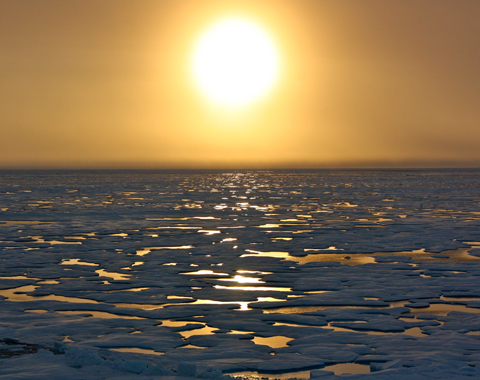
(Credit: NASA Goddard Space Flight Center via Flickr)
We recently highlighted the faulty logic of a pseudoscientific argument against addressing climate change: the proposition that because CO2 is necessary for plants, increasing emissions is good for the planet and the life it supports. Those who read, write or talk regularly about climate change and ecology are familiar with other anti-environmental arguments not coated with a scientific sheen.
A common one is that if you drive a car, buy any plastic goods or even type on a computer keyboard your observation that we need to reduce fossil fuel use is not valid -- no matter how much evidence you present. Like the "CO2 is plant food" claim, it's a poor argument, but for different reasons. It's easy to refute the junk science claim with large amounts of available evidence. This one's simply a logical fallacy.
The statement that gas-fuelled cars cause pollution is true whether or not the person making it drives a car, just as a claim that automobile emissions are harmless is false, regardless of the claimant's car ownership or driving habits.
As well as being a faulty assertion, pointing out the many uses for fossil fuels in an attempt to reject the need to reduce reliance on them is actually an argument in favour of burning less coal, gas and oil. Fossil fuels are useful for many purposes -- from life-saving medical equipment to computer keyboards -- so why extract, transport and burn them so rapidly and wastefully? Supplies aren't endless.
Perhaps some people haven't thought things through. Or maybe they don't have strong arguments against the need to protect the air, water, soil and biodiversity that keeps us healthy and alive. With a subject like climate change, it's somewhat understandable. In this "post-truth" era of infinite information, it's difficult to get a good grasp on many subjects, let alone one as complex and massive as global warming. Most people don't have the time or expertise to read through and comprehend the massive volumes of peer-reviewed science on phenomena such as feedback loops, ocean acidification, extreme weather events, species extinction and sea level rise.
Fortunately, some excellent resources provide information for people with varying levels of knowledge and expertise. Skepticalscience.com offers a big-picture approach by examining the peer-reviewed literature. It's "Most Used Climate Myths" section describes false claims and lets users click for "basic," "intermediate" or "advanced" explanations of real evidence.
You can also find accessible science on the U.S. National Oceanic and Atmospheric Administration and National Aeronautics and Space Administration websites. The American Institute of Physics offers a comprehensive history of climate science, as well as other information.
Media outlets with considerable, credible coverage include The Guardian and National Geographic, and environmentally focused websites such as Grist, EcoWatch and the National Observer. Desmog Blog's timely articles and extensive database shed light on what's behind concerted efforts to downplay or dismiss the seriousness of climate change. Websites for environmental groups like the David Suzuki Foundation, Pembina Institute and others are also good information sources. Just Cool It!, a book coming out April 22 by Foundation senior editor Ian Hanington and me explains climate change and focuses on solutions.
Many other books, websites, publications, films and more offer clear explanations of climate change and what it means for us. The point is that evidence-based information arms people with tools to confront humanity's greatest crisis. It's increasingly clear we can't rely on politicians to get us out of the mess we've created. The current U.S. administration is full of people who reject the overwhelming evidence for human-caused climate change. In Canada, our government has some good climate policies but continues to approve fossil fuel infrastructure projects.
Will good information change the views of those who reject environmental protection? It's hard to know. But for people who care and want to understand, facts are crucial to bringing about much-needed change.
The silver lining of the irrationality that has descended on the U.S. is that it has sparked a growing movement to promote scientific evidence and science-based solutions. The March for Science, taking place in cities throughout the U.S. and beyond on Earth Day, April 22, is one example.
We have scientific evidence and rational arguments on our side. Let's use them to support solutions.
Hey! Want more DSF? Join David Suzuki on Facebook

March 22, 2017
Budget 2017 moves towards a clean energy economy, misses nature protection
VANCOUVER -- The David Suzuki Foundation is encouraged to see the federal government following through on its commitments to invest in clean energy and transit in the 2017 budget. However, the budget misses crucial protection for nature -- the backbone for a healthy environment and thriving economy.
On funding Canada's clean energy economy:
The Foundation applauds the ongoing support for national programs to support the Pan-Canadian Framework on Clean Growth and Climate Change.
"We welcome this budget as a step forward for all communities that want to transition to renewable energy, especially in the North," Foundation science and policy director Ian Bruce said.
Following the $1 billion commitment to clean technology in the 2016 budget, the 2017 budget made a commitment of $2.37 billion over four years to Canada's clean technology industry. As well, the government outlines its plan to invest $21.9 billion over 11 years in green infrastructure.
"Investment in renewables will help stimulate jobs and economic growth -- far more so than supporting a fossil fuel economy," Bruce said.
On stable transit infrastructure:
As many areas of Canada experience increased gridlock, the Foundation welcomes the commitment of phase two public infrastructure funding -- $20.1 billion over 11 years -- to solve this problem.
"This is ongoing, stable funding needed across Canada," Foundation transportation policy analyst Gideon Forman said. "It will engage provinces on national solutions to climate change. Supporting transit is one of the most effective ways to cut down emissions, and improve both air quality and economic performance."
Missing protection for oceans:
While budget elements for climate are robust, nature protection falls short of our expectations.
The Foundation, along with 16 environmental non-profit partners, had advocated for $146 million a year for five years toward marine protected areas and fisheries conservation. Yet, there is no funding allocated in the budget to address this need.
With overwhelming support for ocean protections from Canadians, the Foundation is concerned that this budget falls short.
"Ocean conservation and climate change solutions need to go hand in hand. While developing a clean energy economy we must also make a concerted effort to conserve nature," Foundation Western Region science projects manager Bill Wareham said.
"Last year we applauded the federal government for confirming its mandate to establish new marine protected areas with a goal of protecting at least 10 per cent of our oceans by 2020. This commitment is admirable, but means little if there's no funding to do the work required to meet the goal.
"We're asking the federal government to provide more detail on the Oceans Protection Plan, and how it will help achieve the 10 per cent goal. With less than one per cent currently protected, there's a lot of work to do over the next three years," he said.
30
Media contacts:
Climate, clean energy, and transit
Emily Fister
604-440-5470
Oceans
Theresa Beer
778-874-3396
Hey! Want more DSF? Join David Suzuki on Facebook

Put an end to oil subsidies with a letter to the editor

Hey! Want more DSF? Join David Suzuki on Facebook

March 17, 2017
How to make all-purpose spray cleaner

Keep a bottle under the kitchen and bathroom sinks, in the cleaning closet, etc. (Credit:
Most of us are exposed to cleaning products and their residues every day.
Some contain harmful chemicals linked to cancer, reproductive disorders, asthma and severe allergies. Symbols, like the skull and crossbones, warn us about acute hazards. Labels include words such as "poison," "corrosive" or "irritant."
But Canada does not require warnings about chronic health and environmental hazards of chemicals in cleaning products.
I can't tell you all ingredients to avoid, because product manufactures aren't required to disclose them. Some manufacturers disclose them voluntarily.
Read labels. Avoid these when shopping for store-bought products:
Scented cleaners which may contain synthetic "fragrance" or "parfum"
Anti-bacterial cleaners which may contain "triclosan"
Coloured cleaners which may contain dyes
Better still, make your own!
All-purpose spray recipe
Time needed: five minutes
Shelf life: approximately six months
1.5 L (6 cups) water
60 ml (¼ cup) liquid castile soap
5-10 drops (optional) essential oils, e.g., thyme
Combine all ingredients in a big bowl or jug. Stir and pour into labelled spray bottle(s). (This is a massive batch. I keep a bottle under the kitchen and bathroom sinks, in the cleaning closet, etc.)
Note: Choose liquid castile soap that does not contain palm oil. You can also use liquid castile soap that already contains organic essential oils.
Which essential oils are best?
Thyme is powerful at inhibiting bacterial growth. You can also try lavender, lemon, lime, patchouli and tea tree essential oils. Those with anti-fungal properties include cedarwood, lavender, lemongrass, rosemary and tea tree.
How have you used this recipe? Share your review in the comments below.
Sincerely,
Lindsay Coulter, a fellow Queen of Green
Hey! Want more DSF? Join David Suzuki on Facebook

March 16, 2017
Intact wilderness is a hedge against our ignorance
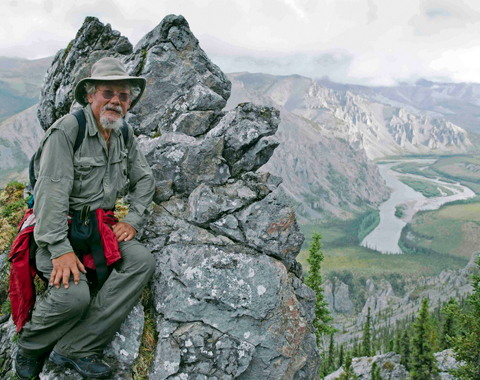
David Suzuki above the Hart River, Yukon (Credit: www.protectpeel.ca)
In 2011, I travelled with my family down Yukon's Hart River. It's one of seven pure rivers in the Peel River watershed, a 68,000-square-kilometre wilderness that's been at the centre of a legal dispute for many years and a land-use planning debate for more than a decade. For two weeks, we fished from the river's vibrant green waters and gazed at the limestone and dolostone peaks of the Ogilvie Mountains.
Most Canadians have never been to the North, much less the remote Peel watershed, but many are enchanted by it, nourished even by the idea that we still have vast, unspoiled natural areas where wildlife and biodiversity continue to evade the touch of humankind. Places like the Peel are becoming increasingly rare as humans -- the most demanding species ever to live -- continue to erode the intact wilderness on which we depend for clean air, water and food.
Around the time of our trip, a six-year land-use planning process for the watershed was reaching its conclusion. In light of an independent commission's recommendation to protect 80 per cent, it looked as if the government was going to keep most of the region free of roads and industry. I could not have imagined that more than five years later, the Peel's fate would be hung up in the courts. The previous Yukon government tossed aside the commission's proposal and brought in its own plan to open up at least 71 per cent of the region to roads, mining and drilling. It was a plan to industrialize the Peel, a plan that valued the wilderness only for the extractive resources that lie beneath it. The decision left the courts as the only option for Indigenous people and environmental organizations working to protect the Peel.
The First Nations of Na Cho Nyäk Dun, Tr'ondëk Hwëch'in, Vuntut Gwitchin and Tetlit Gwich'in, as well as the Canadian Parks and Wilderness Society and the Yukon Conservation Society, have been fighting the government's decision ever since.
If you travel to the Yukon, you will see many vehicles sporting Protect the Peel bumper stickers, a symbol of this small population's determination to stand up against the government's abuse of power, defend the Yukon's modern-day treaties and protect the wilderness that is an enduring part of the northern identity.
On March 22, the Supreme Court of Canada will hear the Peel case. A positive ruling could not only protect the Peel, but also the rights of First Nations in future land-use planning. Because of this, the case is going forward despite the recent election of a Yukon government that seems on the surface to be friendlier to protection.
As we continue to alter the physical, chemical and biological properties of the planet by burning fossil fuels, intact nature is one of the only things that can save us. Pristine wilderness is a hedge against our collective ignorance. The diversity of our planet's ecosystems makes animals, including humans, resilient in the face of disruption. If protected, the Peel watershed would form the northern part of a proposed wildlife corridor that stretches all the way south to Yellowstone National Park in the U.S. It would be a refuge for wide-roaming species like caribou, moose, wolves and grizzlies to adjust their habitat needs as the planet warms.
The Peel case is anchored by the relationship between First Nations and the land. For instance, the Porcupine caribou herd has been the lifeblood of Gwich'in people throughout the Yukon, Northwest Territories and Alaska for tens of thousands of years, providing sustenance and defining their identity. The herd spends its winters in the Peel before making the longest land mammal migration on Earth to its calving grounds in Alaska, a region now threatened by the Trump administration's "drill everywhere" energy stance. As with so many of these battles throughout the world, Indigenous people are holding the line against destructive resource development. Sadly, our colonial governments are not yet willing to listen.
Fittingly, the Supreme Court hearing takes place on World Water Day. Yukoners have been working for 30 years to protect the clean, life-giving waters of the Peel watershed. A victory at the Supreme Court would be a victory for water, wilderness and our future.
Hey! Want more DSF? Join David Suzuki on Facebook

March 14, 2017
2016 Impact Report
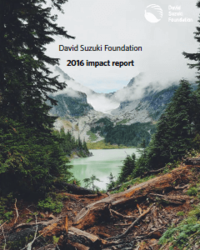
With your support, we achieved many victories in 2016 -- thank you! This report outlines the projects you made possible to combat climate change, protect biodiversity and secure environmental rights. We could not meet our ambitious goals to find solutions to Canada's pressing environmental issues without your ongoing support. These successes are your successes.
Hey! Want more DSF? Join David Suzuki on Facebook

March 9, 2017
Seven tips to help pollinators

Make sure the plants you purchase are pesticide-free. (Credit: Koris Moir)
Native bees and honeybees are still facing decline.
You've already done so much -- made a bee bath, started a mason bee house, built a bumblebee house, even kept a messy yard! I quizzed Shelly Candel, director of Bee City Canada, about her top tips to help pollinators.
Tip 1: Choose native plants. Pollinators are best adapted to local, native plants, shrubs and trees. (I suggest joining a native plant society to find the best local plant lists.)
Tip 2: Get rid of your lawn. It's a desert for pollinators (and most wildlife). Transform it into a pollinator paradise! (I suggest getting your lawn off grass, growing sunflowers, and keeping a mud puddle.)
Tip 3: Bee bountiful. Plant big patches of each native plant species for more efficient foraging (it's less distance for bees to travel). This can also boost curb appeal with big patches of colour to attract both pollinators and humans.
Tip 4: Untidy yards help. Most bees are solitary and nest in the ground. Leave some areas of your property dry, uncultivated and unmulched. Brush piles and dead or dying trees also make great homes for pollinators. Some pollinators also need muddy patches and stones to perch. All bees need a source of water, with a perch. (I say make a bee bath!)
Tip 5: Bee showy. Flowers should bloom in your garden over the seasons, from early spring to late fall. Choose a diversity of native plants and flowers of all shapes and sizes to match pollinator diversity.
Tip 6: Bee chemical-free. Herbicides and pesticides harm bees and other pollinators. Make sure the flowers you purchase are pesticide-free. One study found "23 percent of bee-friendly garden plants sold at top retailers in 14 cities have been treated with neonicotinoid pesticides, the class of pesticides implicated in bee die-offs."
Tip 7: Buy pollinator-friendly food. Support local farmers and beekeepers who do not use neonics.
What else would surprise people about bees?
There are 20,000 known bee species worldwide and more than 800 native bee species in Canada. Each is unique and pollinates different plants at different times. For example, squash bees are the best for squash, pumpkins and gourds!
There are over 140,000 different species of pollinators in Canada. Even a small pollinator garden will bring in many pollinator species, especially native bees. Enjoy your garden and have fun watching these amazing insects at work. My favourite is the green metallic sweat bee, one of the smallest bees and a fast flyer.
What else would you like to know about supporting native bees in your yard or garden?
Sincerely,
Lindsay Coulter, a fellow Queen of Green
Hey! Want more DSF? Join David Suzuki on Facebook

Faulty logic fuels fossil fools
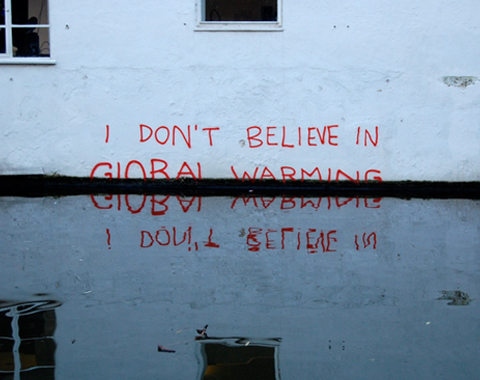
Banksy art, Regent's Canal, London (Photo credit: Magnus D via Flickr)
Apparently, fossil fuel companies protect watersheds and rivers by removing oil. That's according to comments on the David Suzuki Foundation Facebook page and elsewhere, including this: "The amount of contamination occuring [sic] from extraction is far less than if we just left the oil there to continue polluting the waterways."
The "logic" of climate change deniers and anti-environmentalists is often baffling. Although the person who posted that comment doesn't appear to claim professional background or knowledge, Canadian anti-environmentalist Patrick Moore -- who capitalizes on his science degree and long-ago association with Greenpeace to shill for polluting industries -- told the Vancouver Sun in 2011 that oil companies are "leaving the soil cleaner than they found it because they're removing the oil from it."
Those who coat their "alternative facts" with a veneer of "expertise" often employ twisted logic. Take a petition letter urging U.S. President Donald Trump to withdraw from the UN Framework Convention on Climate Change.
Letter author Richard Lindzen, a climate skeptic whose work has often been debunked, claims "more than 300 eminent scientists and other qualified individuals from around the world" signed the petition. What kind of "eminent scientists" would sign something claiming carbon dioxide "is not a pollutant but a major benefit to agriculture and other life on Earth" and that "warming from increased atmospheric CO2 will be benign"?
The idea that CO2 is little more than plant food is common in denier circles, floated recently by the U.S. Heartland Institute, its affiliated industry promoters like Canadians Patrick Moore and Tom Harris, and others. In a 2014 book, two signatories to the Trump letter, retired Environment Canada scientist Madhav Khandekar and retired Australian geology professor Cliff Ollier, along with database marketing consultant Arthur Middleton Hughes, wrote the world should burn more coal "to produce electricity and increase CO2 in the atmosphere." They also argue for more use of the pesticide DDT.
We've addressed the debunked CO2 argument before. It ignores pollution from burning coal and other fossil fuels, and the complexity and interconnectedness of natural systems. Many plants do need CO2, but it doesn't follow that more CO2 is better, or that CO2 is the only factor in plant growth. Studies show rising temperatures often hinder plant growth and nutritional value. And droughts, floods and other increasingly extreme and unpredictable weather events brought on by climate change are not beneficial to agriculture or plant growth. We also need oxygen to live, but too much can be toxic.
So, who are the "300 eminent scientists and other qualified individuals" who put their names to such unscientific nonsense? Like Khandekar, many are affiliated with the industry-funded Heartland Institute, which has promoted tobacco and compared climate scientists to the Unabomber and Charles Manson.
A Desmog Blog investigation described the 300 as "medical doctors, mystery men, coal executives, petroleum engineers, economists, and think tank members. Only a small handful could be considered even remotely 'qualified' or 'eminent' -- but not in the field of climate science." Many show no academic affiliation or address. Canadians are represented by the likes of Khandekar and Moore.
Moore once even claimed glaciers are "dead zones" that we'd be better off without! There's that twisted logic. It's true plants don't grow on glaciers, but microorganisms and other life do. Saying "Ice and frost are the enemies of life" is absurd -- especially for those of us who require water to live!
Another signatory, William Happer, is a retired physics professor being eyed as Trump's science adviser. Greenpeace once caught him in a sting in which he agreed to write an article touting the benefits of coal and to fake its peer-review status.
People posting nonsensical comments on Facebook might simply be uninformed or misinformed. But it's hard not to conclude that many of the so-called "experts" are being deliberately deceptive. Any scientifically literate person who has examined the massive amounts of evidence for human-caused global warming and its consequences, collected over many decades from around the world, wouldn't fall for such easily debunked claims.
In this "post-truth" era, with a climate-change-denying U.S. administration, those who want to keep humanity wedded to outdated, polluting technologies have been emboldened. It's up to the rest of us to cut through the misinformation and help humanity get on track to a cleaner, healthier future.
Hey! Want more DSF? Join David Suzuki on Facebook

March 8, 2017
Power up Canada with renewable energy
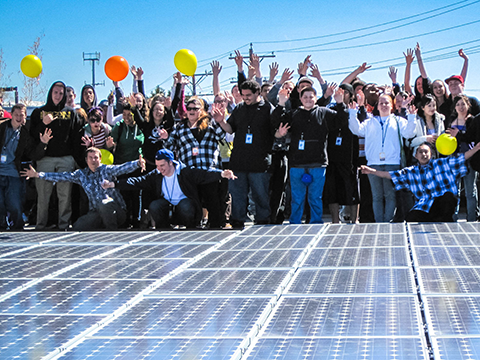
(Credit: Black Rock Solar via Flickr / CC BY)
The global push for renewables is on, and it's time for Canada to seize the opportunity to propel our energy economy to a stable and promising future. With dramatically dropping costs, renewable energy is becoming the best environmental energy choice and the best economic choice.
Hey! Want more DSF? Join David Suzuki on Facebook

David Suzuki's Blog
- David Suzuki's profile
- 247 followers



